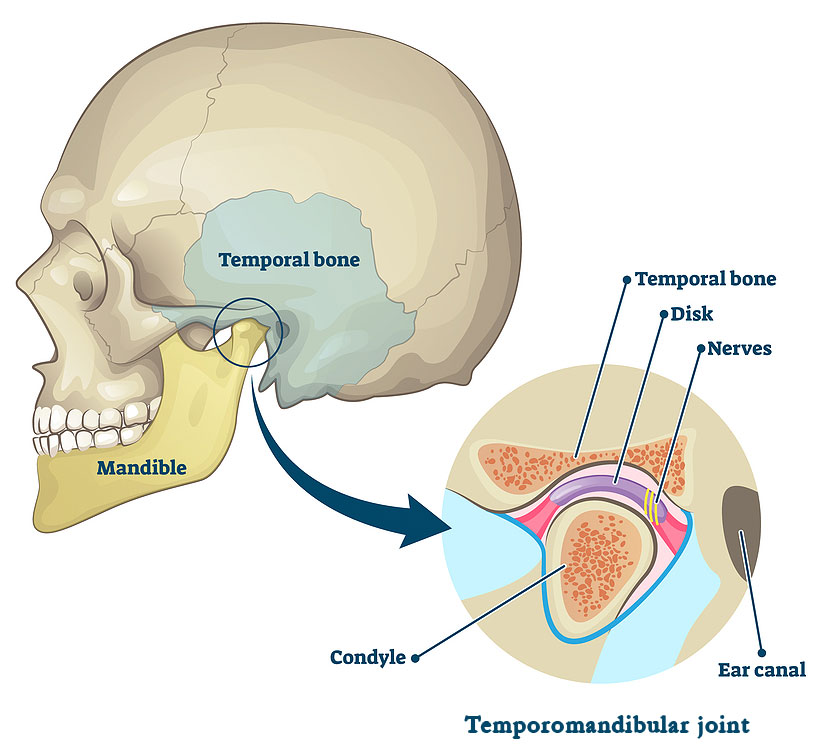TMD (TMJ)
DENTISTRY
TMD 101
What is tmd (Temporomandibular Disorder)?
You may have heard TMJ and TMD used interchangeably by people to describe pain or other symptoms associated with the jaw. In fact, TMJ (or temporomandibular joint) is the jaw joint itelf, whereas TMD is the clinical term for conditions that affect this joint.
Pain associated with the face, jaw, ears, temples, teeth, shoulders or neck is the most common symptom of TMD and the reason people seek treatment. Other symptoms include an inability to open the mouth as wide as normal or a jaw that gets “locked” in the open or closed position (while yawning, for example, or clenching), clicking, popping or grinding sounds in the jaw difficulty/soreness after chewing and ringing in the ears (tinnitus).
It’s important to consider that the mouth is a very complex system that is connected to many other systems in the body. There are many possible causes for facial pain and discomfort. Some instances of facial dicomfort may resolve themselves, some require intervention by a dentist, others may be a sign of other disease or imbalance in the body. The first step is getting a proper diagnosis.
Meet the amazing jaw joint
The TMJ is the joint that connects the lower jaw (mandible) to the temporal bone of the skull, which is immediately in front of each ear. It’s a very interesting structure that functions differently from every other joint in the body. The top portion of the jaw is shaped like a ball. This “ball” fits neatly into a socket that is positioned in the skull. When your mouth is closed, the ball rests in this socket. As you begin to open your mouth, the ball rotates. As you continue to open your mouth wider, the ball actually leaves the socket and begins to slide down a ramp that is directly in front of the socket. You can feel this happen if you lightly press on the area the area directly in front of your ears and open your mouth slowly.
Muscles attached to the TMJ control the position and extension of the jaw while a disk-shaped cushion that sits between the lower jaw and skull essentially makes the movement of bone against bone possible.

What Causes TMD
The TMJ (or Temporomandibular Joint) is so unique in its design and function. It allows the mouth to move in ways that perform functions we often take for granted. Eating, talking, breathing…singing an aria all depend on the ability of the mouth to articulate in multiple ways. When any part of this complex system is not functioning fully, it can cause discomfort or pain. Muscle dysfunction is the number one cause of TMJ related pain.
How is TMD Diagnosed
There are several ways Dr. Friedman can determine the cause of a patient’s TMJ dysfunction.
These include:
History – Much of the diagnostic information will come from the history that you provide. Questions you will be asked include include when the issue started, whether there has been any change and what type of treatment, if any, have you received for this issue.
Listening and Observation Listening to and feeling your jaw when you open and close your mouth and observing the range of motion of your jaw will also provide useful information.
Palpating for Discomfort Pressing on specific areas around your jaw can identify sites of pain or discomfort.
Diagnostic Imaging X-rays may be helpful if a problem with your teeth is suspected. In addition a A CT scan can provide detailed images of the bones involved in the joint and MRI’s can reveal problems with the TMJ disk.
How is TMD Treated
The complexity of the TMJ lends itself to many different types of treatment. A clear and concise diagnosis of exactly the cause of the dysfunction will see that the proper treatment is prescribed.
Othopaedic Bite Guard/Night Guard
The term occlusal refers to the biting surfaces of the teeth. The “guard” is made of clear acrylic. It is hard and does not soften with warm water. The “guard” is very comfortable to wear because Dr. Friedman addresses the system made of the TMJ’s, teeth and the jaw chewing muscles as the ORTHOPAEDIC system it is. This treatment is widely used because it is almost always helpful and because it is reversible (no permanent changes to the system have occurred).
Occlusal Equilibration
If it is determined that your bite is causing your TMJ symptoms, an occlusal adjustment may be necessary. The biting surfaces of the teeth are recontoured to fit and function without stressing the TMJ’s. Occasionally, impressions of your teeth may be helpful in determining if occlusal equilibration is right for you.
Orthodontics
If the position and fit of your teeth are causing TMJ symptoms, you may need to reposition your teeth by orthodontics. This therapy is often prescribed when Dr. Friedman recognizes that the teeth are not fitting together properly, but where an occlusal adjustment cannot be performed.
Surgery
Surgery is used to treat only the very worst cases of TMJ disorders. In cases that have a bone or disk derangement that has degraded the joint to a point that the patient cannot function, surgery may be the only option. The types of surgery vary from scoping to complete joint replacement.
TMD is very common and, with proper diagnosis, very treatable.
If you’re living with symptoms of TMD, call us as soon as possible. Treatment is available and it may be easier than you think to get relief from the pain and discomfort of this common affliction.
Schedule a Complimentary Consultation with Dr. Friedman
30 St. Clair Avenue West
Suite 102
Toronto , M4V 3A1
416-482-9100
Office Hours
Fridays by Appointment
Schedule a Complimentary Consultation with Dr. Friedman
30 St. Clair Avenue West
Suite 102
Toronto , M4V 3A1
416-482-9100
OFFICE HOURS
Fridays by Appointment